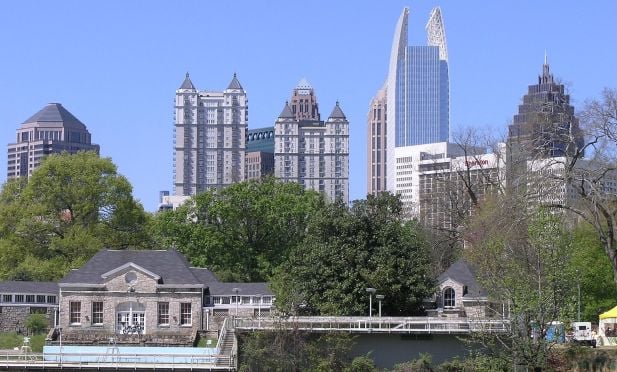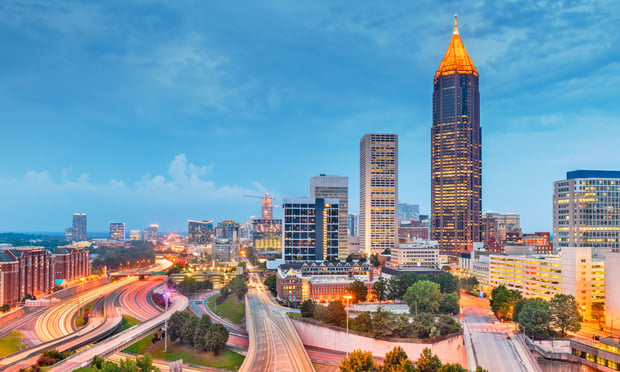
ATLANTA—Atlanta made headlines for all the wrong reasons last week when the northbound lane of Interstate 85 collapsed after a fire under the bridge. The section that connected the hot commercial real estate markets of Midtown and Buckhead were interrupted.
According to a study completed by INRIX, a transportation consulting firm, Atlanta has the fourth-worst traffic in the United States, with commuters losing an average of 70.8 hours to congestion on an annual basis. Based on observed traffic patterns on the day immediately after the collapse, says a CBRE report authored by Southeast research director Dan Wagner and Southeast research manager Brian Reed, it is not hyperbole to expect Atlanta's congestion to immediately be worse than any other market in the country.
“More than 250,000 vehicles per day traverse this major interstate artery. Atlanta is infamous for its traffic gridlock in the Southeast and the loss of a major transportation corridor will only expand its reputation,” they wrote. “While implications to commuters are front-of-mind, it is important to note that Atlanta is also a critical distribution hub for the entire country with over 400 million square feet of warehouse space occupied by users that rely heavily on the existing road network. While many commuters can offset the loss of infrastructure through telecommuting, there is no way to soften the blow for industries that rely on local trucking.”
CBRE also noted the section of interstate impacted connects the two major office hubs of Atlanta in Midtown and Buckhead and is less than one mile from the on-ramp of Georgia 400, a major local transportation artery. Compounding the problem, the firm said, is the site's proximity to “spaghetti junction,” the interchange of Interstate 285 and Interstate 85. It's already the worst trucking bottle neck in the US, according to the American Transportation and Research Institute. (Will this major redevelopment spark more momentum in Midtown?)
What are the implications? Kirk Rich, a principal in Avison Young's Atlanta office, tells GobeSt.com the issue is extremely temporary. He doesn't believe it will cause any major, permanent trend—but admits it will change behavior for the next three to nine months with regards to work patterns.
“People will have to lean on mass transit now more than ever in Atlanta and I think they will realize it's not such a bad option,” says Rich, who is running for City Council in Atlanta's 6th District. “In fact, I think it may be a big positive.”
CBRE reports the bulk of the economic growth in the Southeast occurred after the advent of the automobile. As a result, the firm notes, development patterns are not conducive to the strong adoption of mass transit and the negative consequences of disruption are stronger in these rapidly growing markets. Wagner and Reed agree that perhaps the biggest winner in this situation is MARTA, which immediately added capacity in response to the situation and can expect to see historic ridership levels in the coming months.
“For the commercial real estate world, the bridge collapse may cause decision makers to be hesitant about making an imminent move and instead letting those decisions play out over a longer period of time so companies don't have to move in the middle of this temporary chaos,” Rich says. “Once the bridge is repaired there may be some pent up demand for deals but I don't see this three to nine month issue causing major shifts in people's behavior on leasing space or in their selection of where they want to be.”
While the failure of vital infrastructure is never a positive, the situation could have been worse for the industrial sector, according to Wagner and Reed. When given a choice, trucking companies typically elect to route around the stretch of I-85 that traverses the heart of Atlanta.
“This means the bulk of logistics traffic typically does not use this artery,” they wrote. “While they will endure increases in traffic congestion, a failure of I-85 is not as crippling to the sector as a failure of part of The Perimeter, the I-285 interstate beltway.”
Who will win in transit-oriented development trends? Check out one view.

ATLANTA—Atlanta made headlines for all the wrong reasons last week when the northbound lane of Interstate 85 collapsed after a fire under the bridge. The section that connected the hot commercial real estate markets of Midtown and Buckhead were interrupted.
According to a study completed by INRIX, a transportation consulting firm, Atlanta has the fourth-worst traffic in the United States, with commuters losing an average of 70.8 hours to congestion on an annual basis. Based on observed traffic patterns on the day immediately after the collapse, says a CBRE report authored by Southeast research director Dan Wagner and Southeast research manager Brian Reed, it is not hyperbole to expect Atlanta's congestion to immediately be worse than any other market in the country.
“More than 250,000 vehicles per day traverse this major interstate artery. Atlanta is infamous for its traffic gridlock in the Southeast and the loss of a major transportation corridor will only expand its reputation,” they wrote. “While implications to commuters are front-of-mind, it is important to note that Atlanta is also a critical distribution hub for the entire country with over 400 million square feet of warehouse space occupied by users that rely heavily on the existing road network. While many commuters can offset the loss of infrastructure through telecommuting, there is no way to soften the blow for industries that rely on local trucking.”
CBRE also noted the section of interstate impacted connects the two major office hubs of Atlanta in Midtown and Buckhead and is less than one mile from the on-ramp of Georgia 400, a major local transportation artery. Compounding the problem, the firm said, is the site's proximity to “spaghetti junction,” the interchange of Interstate 285 and Interstate 85. It's already the worst trucking bottle neck in the US, according to the American Transportation and Research Institute. (Will this major redevelopment spark more momentum in Midtown?)
What are the implications? Kirk Rich, a principal in Avison Young's Atlanta office, tells GobeSt.com the issue is extremely temporary. He doesn't believe it will cause any major, permanent trend—but admits it will change behavior for the next three to nine months with regards to work patterns.
“People will have to lean on mass transit now more than ever in Atlanta and I think they will realize it's not such a bad option,” says Rich, who is running for City Council in Atlanta's 6th District. “In fact, I think it may be a big positive.”
CBRE reports the bulk of the economic growth in the Southeast occurred after the advent of the automobile. As a result, the firm notes, development patterns are not conducive to the strong adoption of mass transit and the negative consequences of disruption are stronger in these rapidly growing markets. Wagner and Reed agree that perhaps the biggest winner in this situation is MARTA, which immediately added capacity in response to the situation and can expect to see historic ridership levels in the coming months.
“For the commercial real estate world, the bridge collapse may cause decision makers to be hesitant about making an imminent move and instead letting those decisions play out over a longer period of time so companies don't have to move in the middle of this temporary chaos,” Rich says. “Once the bridge is repaired there may be some pent up demand for deals but I don't see this three to nine month issue causing major shifts in people's behavior on leasing space or in their selection of where they want to be.”
While the failure of vital infrastructure is never a positive, the situation could have been worse for the industrial sector, according to Wagner and Reed. When given a choice, trucking companies typically elect to route around the stretch of I-85 that traverses the heart of Atlanta.
“This means the bulk of logistics traffic typically does not use this artery,” they wrote. “While they will endure increases in traffic congestion, a failure of I-85 is not as crippling to the sector as a failure of part of The Perimeter, the I-285 interstate beltway.”
Who will win in transit-oriented development trends? Check out one view.
Want to continue reading?
Become a Free ALM Digital Reader.
Once you are an ALM Digital Member, you’ll receive:
- Breaking commercial real estate news and analysis, on-site and via our newsletters and custom alerts
- Educational webcasts, white papers, and ebooks from industry thought leaders
- Critical coverage of the property casualty insurance and financial advisory markets on our other ALM sites, PropertyCasualty360 and ThinkAdvisor
Already have an account? Sign In Now
*May exclude premium content© 2025 ALM Global, LLC, All Rights Reserved. Request academic re-use from www.copyright.com. All other uses, submit a request to [email protected]. For more information visit Asset & Logo Licensing.








